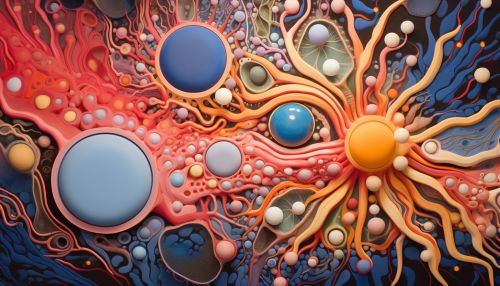Eukaryote
Introduction
Eukaryotes are organisms whose cells have a nucleus enclosed within a nuclear envelope, which includes animals, plants, and fungi, as well as various other groups. The defining feature of eukaryotic cells is the presence of a nucleus, a membrane-bound compartment that houses the cell's DNA. This is a key distinction between eukaryotes and their prokaryotic counterparts, which lack a nucleus and other membrane-bound organelles.


Cell Structure
Eukaryotic cells are typically much larger than prokaryotes. They have a variety of internal membrane-bound structures, collectively referred to as organelles. These structures serve a range of functions, from providing physical support to the cell to carrying out specific chemical reactions.
Nucleus
The nucleus is the most prominent organelle in a eukaryotic cell. It is surrounded by a double membrane, known as the nuclear envelope, which separates the contents of the nucleus from the rest of the cell. The nucleus contains the cell's DNA, organized into structures called chromosomes.
Mitochondria
Mitochondria are often referred to as the "powerhouses" of the cell because they generate most of the cell's supply of adenosine triphosphate (ATP), the main source of energy for cellular reactions.
Endoplasmic Reticulum
The endoplasmic reticulum (ER) is a network of tubules and sacs that plays a key role in protein synthesis and lipid metabolism.
Golgi Apparatus
The Golgi apparatus is involved in the modification, sorting, and packaging of proteins for secretion. It is also involved in the transport of lipids around the cell, and the creation of lysosomes.
Lysosomes
Lysosomes contain enzymes that break down waste materials and cellular debris. They can be thought of as the cell's "garbage disposal."
Peroxisomes
Peroxisomes are involved in the breakdown of very long chain fatty acids, branched chain fatty acids, D-amino acids, and polyamines.
Cytoskeleton
The cytoskeleton is a complex network of interlinking filaments and tubules that extend throughout the cytoplasm, providing a structural framework for the cell.
Reproduction
Eukaryotes can reproduce both sexually and asexually. In sexual reproduction, two cells (usually from different individuals) fuse to form a zygote. In asexual reproduction, a single parent cell divides to produce two identical daughter cells.
Mitosis
Mitosis is a form of cell division that results in two daughter cells each having the same number and kind of chromosomes as the parent nucleus.
Meiosis
Meiosis is a type of cell division that reduces the number of chromosomes in the parent cell by half and produces four gamete cells.
Evolution
The origin of the eukaryotic cell is a milestone in the evolution of life, since they include all complex cells and almost all multicellular organisms. The timing of this series of events is hard to determine; Knoll suggests they developed approximately 1.6–2.1 billion years ago.
Classification
Eukaryotes are classified into three main groups: plants, animals, and fungi. Each of these groups is thought to have evolved from a common ancestor.
